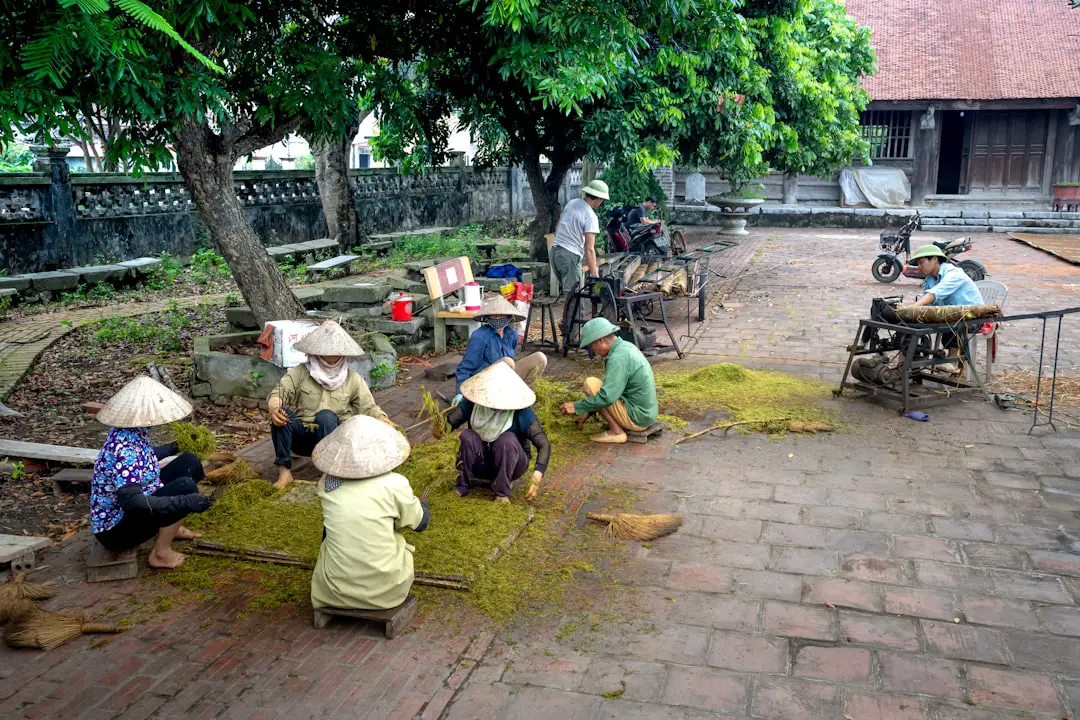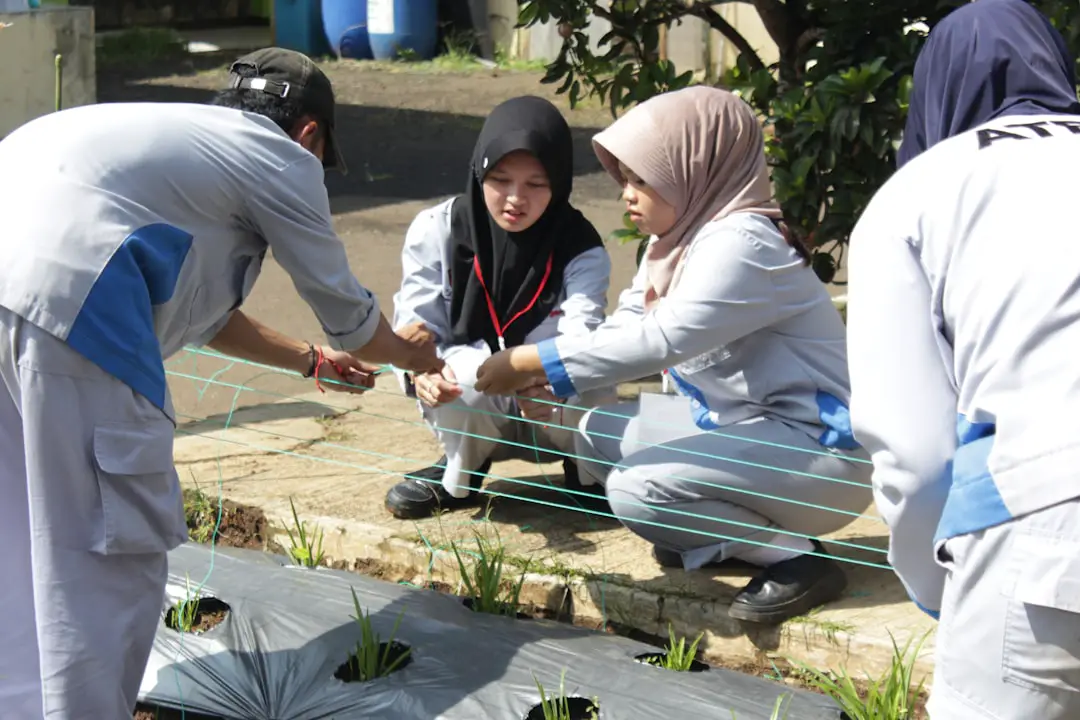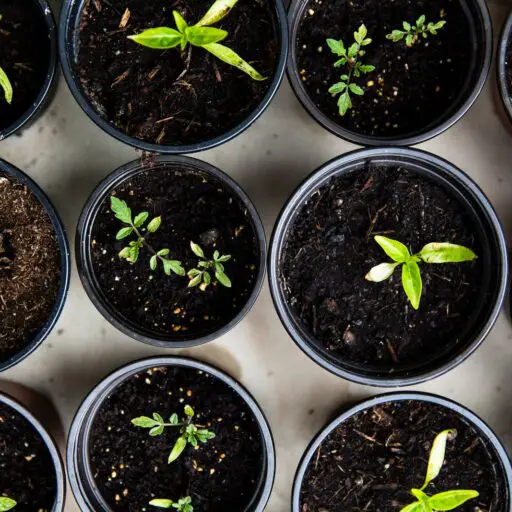Support our educational content for free when you purchase through links on our site. Learn more

Imagine turning a vacant, neglected lot into a buzzing oasis of fresh veggies, buzzing bees, and friendly neighbors sharing stories over ripe tomatoes. Sounds like a dream, right? But that’s exactly what community gardens do—transforming not just land, but entire neighborhoods. In this article, we’ll uncover 8 surprising ways community gardens help the community, from boosting food security and mental health to reducing crime and sparking economic growth. Whether you’re curious about starting your own garden or just want to understand their magic, we’ll dig into the science, stories, and step-by-step tips to show why these green spaces are true urban superheroes.
Did you know that greening vacant lots with community gardens can reduce gun violence by over 20%? That’s just one of the many powerful impacts we’ll explore. Ready to see how planting seeds can grow stronger, healthier, and safer communities? Let’s get started!
Key Takeaways
- Community gardens improve food security by providing fresh, affordable produce in urban food deserts.
- They boost mental health and social connections, reducing stress and fostering community bonds.
- Gardens enhance urban ecosystems, supporting pollinators and improving air quality.
- They contribute to economic benefits like saving money, job skills, and increasing property values.
- Community gardens act as crime deterrents by activating neglected spaces and increasing neighborhood safety.
- They serve as educational hubs, teaching sustainability and gardening skills across generations.
- Inclusivity in gardens promotes diversity, equity, and cultural exchange.
- Starting a garden requires planning, collaboration, and community engagement—but the rewards are huge!
Ready to grow your own community garden? Check out seeds and supplies from trusted brands:
- Johnny’s Selected Seeds on Amazon | Burpee Seeds on Amazon | Johnny’s Official Website | Burpee Official Website
Table of Contents
- ⚡️ Quick Tips and Facts About Community Gardens
- 🌱 Growing Together: The History and Evolution of Community Gardens
- 1️⃣ How Community Gardens Boost Local Food Security and Nutrition
- 2️⃣ Building Bonds: Social and Mental Health Benefits of Community Gardening
- 3️⃣ Environmental Impact: How Community Gardens Help Urban Ecosystems Thrive
- 4️⃣ Economic Advantages: Saving Money and Creating Opportunities Through Community Gardens
- 5️⃣ Educational Powerhouses: Teaching Sustainability and Gardening Skills
- 6️⃣ Community Gardens as Crime Fighters: Reducing Crime and Increasing Safety
- 7️⃣ Inclusivity in Action: How Community Gardens Foster Diversity and Equity
- 8️⃣ Getting Started: How to Launch a Successful Community Garden in Your Neighborhood
- 🌿 Quick Tips for Maintaining a Thriving Community Garden
- 🔗 Recommended Resources and Organizations Supporting Community Gardens
- ❓ Frequently Asked Questions About Community Gardens
- 📚 Reference Links and Further Reading
- 🎯 Conclusion: Why Community Gardens Are a Win for Everyone
⚡️ Quick Tips and Facts About Community Gardens
Welcome to the green heart of community magic! At Community Gardening™, we’ve seen firsthand how community gardens are more than just patches of dirt—they’re vibrant hubs that nourish bodies, minds, and neighborhoods alike. Here are some quick facts and tips to get you started:
- ✅ Community gardens increase access to fresh fruits and veggies, especially in urban food deserts.
- ✅ They promote physical activity, helping gardeners meet recommended exercise levels.
- ✅ These gardens foster social connections, reducing isolation and building neighborhood trust.
- ✅ Community gardens can reduce local crime rates by transforming neglected spaces into cared-for green areas.
- ✅ They serve as outdoor classrooms, teaching gardening, sustainability, and nutrition skills.
- ✅ Soil safety is crucial—test your soil for contaminants before planting edible crops!
- ✅ Start small, plan collaboratively, and keep communication open for a thriving garden.
Want to dive deeper? We’ve got you covered with stories, science, and step-by-step guidance ahead. Curious how these humble plots can transform entire communities? Keep reading! 🌿
For a practical jumpstart, check out our guide on How to Start a Small Urban Garden.
🌱 Growing Together: The History and Evolution of Community Gardens

Community gardens have roots that dig deep into human history. From ancient civilizations cultivating shared plots to the famed Victory Gardens of World War II, these gardens have always been about more than just food—they’re about resilience, unity, and hope.
A Walk Through Time
- Ancient Origins: Archaeological evidence shows communal gardening dating back over 2,000 years, where shared agriculture was essential for survival and social cohesion.
- Victory Gardens (WWII): Millions of Americans grew their own vegetables to support the war effort, boosting morale and food security.
- Urban Renewal (1960s-70s): As cities faced decay and social fragmentation, community gardens re-emerged as grassroots solutions to reclaim neglected spaces and rebuild neighborhoods.
- Global Movement: Today, community gardens thrive worldwide—from New York’s GreenThumb program to London’s Incredible Edible initiative, all emphasizing sustainability and social equity.
Why History Matters
Understanding this evolution shows us that community gardens are not a fad but a proven tool for social and environmental health. They adapt to the needs of their times, whether fighting food scarcity or fostering urban biodiversity.
For more on the historical context, see the Environmental Evidence Journal’s comprehensive review.
1️⃣ How Community Gardens Boost Local Food Security and Nutrition
One of the most celebrated benefits of community gardens is their direct impact on food security—especially in urban areas where fresh produce can be scarce or expensive.
The Food Desert Fighter
Community gardens often flourish in “food deserts,” neighborhoods lacking affordable, healthy food options. By growing fruits, vegetables, and herbs locally, gardeners gain:
- Fresh, nutritious produce right at their doorstep.
- Reduced reliance on processed foods, improving overall diet quality.
- Opportunities to try new crops like kale, snow peas, or heirloom tomatoes, boosting dietary diversity.
Nutrition and Awareness
Gardening also educates participants about seasonal eating, organic growing methods, and food preparation. This hands-on learning often translates into healthier eating habits for gardeners and their families.
Real-Life Impact
At Community Gardening™, we’ve seen families report increased vegetable intake after joining gardens. One gardener shared, “I never thought I’d enjoy kale until I grew it myself—now it’s a staple at dinner!”
Crop Recommendations for Beginners
| Crop | Benefits | Ease of Growth | Climate Suitability |
|---|---|---|---|
| Strawberries | Rich in vitamin C, kid-friendly | Easy | Moderate climates |
| Kale | High in vitamins A, K, C | Moderate | Cool to moderate |
| Radishes | Quick-growing, crunchy | Very easy | Most climates |
| Snow Peas | Protein source, sweet taste | Moderate | Cooler seasons |
| Blueberries | Antioxidants, requires acidic soil | Moderate | Acidic soil, temperate zones |
Want to learn how to select and prepare your site? Check out our Garden Design Ideas for inspiration.
2️⃣ Building Bonds: Social and Mental Health Benefits of Community Gardening
Community gardens are social glue. They bring people together, fostering friendships, reducing loneliness, and improving mental well-being.
The Social Butterfly Effect
- Shared goals create natural opportunities for collaboration and conversation.
- Intergenerational exchange happens as seasoned gardeners mentor newcomers or youth.
- Cultural exchange flourishes when diverse communities grow traditional crops and share recipes.
Mental Health Boosters
Gardening is therapeutic. Studies show that time spent in green spaces reduces stress, anxiety, and depression. The physical activity involved releases endorphins, while nurturing plants fosters a sense of accomplishment.
One of our gardeners, Maria, told us, “After a tough day, digging in the garden is my therapy. It clears my mind and connects me to something bigger.”
Community Resilience
These social ties build social capital, which strengthens neighborhoods against challenges like economic downturns or natural disasters.
For more on the mental health benefits, see the Environmental Evidence Journal’s findings.
3️⃣ Environmental Impact: How Community Gardens Help Urban Ecosystems Thrive
Community gardens are green lungs in concrete jungles. They improve urban environments in multiple ways:
Biodiversity Boost
- Gardens attract pollinators like bees and butterflies, essential for ecosystem health.
- Native plants and flowers support local wildlife and birds.
Climate and Air Quality Benefits
- Plants absorb CO2 and release oxygen, helping mitigate urban heat islands.
- Gardens reduce dust and pollution, improving air quality.
Waste Reduction and Soil Health
- Many gardens practice composting, turning food scraps into nutrient-rich soil amendments.
- This reduces landfill waste and enhances soil fertility naturally.
Water Management
- Gardens can incorporate rain gardens or permeable surfaces to reduce stormwater runoff and flooding.
Soil Safety
Urban soils may contain contaminants like lead. Testing soil before planting edible crops is essential to avoid health risks. Local extension services or organizations like SoilSafe offer testing kits and advice.
4️⃣ Economic Advantages: Saving Money and Creating Opportunities Through Community Gardens
Community gardens aren’t just good for health and environment—they also make economic sense.
Save on Grocery Bills
Growing your own food cuts down on produce expenses. Even small plots can yield significant harvests, especially with high-value crops like herbs and salad greens.
Job Skills and Employment
Gardening teaches valuable skills—horticulture, project management, teamwork—that can boost employability. Some gardens partner with local nonprofits to offer job training programs.
Property Value and Neighborhood Appeal
Greening vacant lots can increase nearby property values and attract new residents or businesses. A well-maintained garden signals community pride and safety.
Economic Multiplier Effect
Local markets or farm stands selling surplus produce keep money circulating within the community, supporting other local businesses.
5️⃣ Educational Powerhouses: Teaching Sustainability and Gardening Skills
Community gardens are living classrooms for all ages.
Hands-On Learning
- Soil preparation, planting, pest management, and harvesting teach practical skills.
- Lessons in composting, water conservation, and organic growing promote environmental stewardship.
Youth Engagement
Gardens often host school programs or youth clubs, sparking interest in science, nutrition, and ecology. This early exposure can inspire lifelong healthy habits.
Adult Education
Workshops on topics like seed saving, container gardening, or native plants empower gardeners to expand their skills.
Mentorship and Leadership
Experienced gardeners mentor newcomers, fostering leadership and community ownership.
Check out our Community Garden Events for upcoming workshops and programs.
6️⃣ Community Gardens as Crime Fighters: Reducing Crime and Increasing Safety
Believe it or not, planting flowers and veggies can make your neighborhood safer!
The “Eyes on the Street” Effect
Active gardens bring more people outdoors, increasing natural surveillance and deterring crime. Well-lit, well-maintained gardens signal community care, discouraging vandalism and illegal activity.
Research-Backed Impact
- Studies in Philadelphia showed that greening vacant lots reduced gun violence by 20% or more.
- Residents report feeling safer and more connected in neighborhoods with community gardens.
Healing Blight
Transforming abandoned lots into gardens reduces urban decay, which is often linked to higher crime rates.
7️⃣ Inclusivity in Action: How Community Gardens Foster Diversity and Equity
Community gardens can be powerful tools for social justice—when designed with inclusivity in mind.
Breaking Barriers
- Gardens welcome people of all ages, ethnicities, and income levels.
- They provide access to land and fresh food for those who might otherwise be excluded.
Cultural Expression
Gardens allow diverse communities to grow culturally significant crops and share traditions, strengthening identity and pride.
Addressing Inequities
By reclaiming neglected spaces in underserved neighborhoods, gardens combat environmental injustice and food inequality.
Beware of Exclusion
However, gardens can unintentionally exclude if resources or leadership are not accessible. We recommend proactive outreach and equitable governance structures.
For policy insights, visit our Community Garden Policies section.
8️⃣ Getting Started: How to Launch a Successful Community Garden in Your Neighborhood
Ready to roll up your sleeves? Here’s a detailed roadmap from our Community Gardening™ experts:
Step 1: Gather Your Team
- Find passionate neighbors or local organizations interested in gardening.
- Form a leadership group to coordinate efforts.
Step 2: Find and Assess a Site
- Look for vacant lots, parks, or unused land.
- Test soil for contaminants (contact local extension services).
- Ensure access to water and sunlight.
Step 3: Secure Permissions
- Obtain necessary permits or leases from landowners or city agencies.
- Check zoning laws and community garden ordinances.
Step 4: Plan Your Garden Design
- Decide on individual plots vs. communal beds.
- Incorporate accessibility features (raised beds, wide paths).
- Plan for composting, tool storage, and seating areas.
Step 5: Fundraise and Gather Resources
- Apply for grants from organizations like the American Community Gardening Association.
- Host fundraisers or seek donations of tools and seeds from brands like Burpee or Johnny’s Selected Seeds.
Step 6: Launch and Maintain
- Host a kickoff event to build excitement.
- Create a calendar for planting, watering, and harvesting.
- Encourage regular volunteer involvement and community events.
Step 7: Keep Growing
- Evaluate progress and adapt as needed.
- Foster leadership development and community ownership.
For inspiration, check out our Garden Design Ideas and Edible Plants guides.
🌿 Quick Tips for Maintaining a Thriving Community Garden
Maintaining a community garden takes teamwork and TLC. Here are our top tips:
- Regular Watering: Set up drip irrigation or rain barrels to conserve water.
- Soil Health: Rotate crops and add compost annually to maintain fertility.
- Pest Management: Use organic methods like companion planting and neem oil.
- Tool Care: Keep tools clean and sharp; store them securely.
- Communication: Use group chats or bulletin boards to coordinate tasks and events.
- Celebrate Success: Host harvest parties or potlucks to build morale.
- Inclusivity: Welcome new members and respect diverse gardening styles.
Remember, a happy garden is a productive garden! 🌻
🔗 Recommended Resources and Organizations Supporting Community Gardens
Looking for expert help or funding? Here are some trusted resources:
| Organization | Focus Area | Website |
|---|---|---|
| American Community Gardening Assoc. | Advocacy, education, grants | communitygarden.org |
| GreenThumb (NYC) | Urban garden support | greenthumb.nycgovparks.org |
| USDA Urban Agriculture Program | Funding and technical assistance | usda.gov |
| SoilSafe | Soil testing and safety | soilsafe.org |
| Johnny’s Selected Seeds | Seeds and gardening supplies | johnnyseeds.com |
| Burpee Seeds | Seeds and plants | burpee.com |
👉 Shop Seeds and Supplies on:
- Johnny’s Selected Seeds on Amazon | Burpee on Amazon | Johnny’s Official Website | Burpee Official Website
❓ Frequently Asked Questions About Community Gardens
Q: Do I need gardening experience to join a community garden?
A: ❌ Not at all! Community gardens are welcoming to all skill levels. Many offer workshops and mentorship.
Q: How do community gardens handle conflicts or disagreements?
A: Most gardens establish clear rules and communication channels upfront. Regular meetings and a code of conduct help keep things smooth.
Q: Can I grow any type of plant in a community garden?
A: Usually yes, but check local guidelines. Many gardens encourage edible plants but welcome flowers and native species too.
Q: Is it expensive to participate?
A: Often, plots are free or low-cost. Some gardens ask for volunteer hours or small fees to cover water and maintenance.
Q: How do community gardens impact the environment?
A: They improve biodiversity, reduce urban heat, and promote sustainable practices like composting and rainwater harvesting.
For more FAQs, visit our Benefits of Community Gardens page.
📚 Reference Links and Further Reading
- Environmental Evidence Journal: Health and Well-being Impacts of Community Gardening
- Tulane Public Health Blog: Benefits of Community Gardens
- Pennsylvania Horticultural Society: Gardeners Blog
- American Community Gardening Association
- USDA Urban Agriculture Program
These resources offer deep dives into research, practical advice, and community stories that will inspire your gardening journey. Happy growing! 🌻
Stay tuned for the conclusion, where we’ll wrap up why community gardens are truly a win-win for everyone involved!
🎯 Conclusion: Why Community Gardens Are a Win for Everyone
After digging deep into the many layers of community gardens, it’s clear: these green spaces are powerhouses of positive change. They don’t just grow plants—they grow healthier bodies, stronger communities, and greener cities.
From boosting food security and nutrition to nurturing mental health and social bonds, community gardens are a multifaceted solution to many urban challenges. They transform neglected lots into vibrant ecosystems that support biodiversity and reduce crime, while also teaching valuable skills and creating economic opportunities.
We opened this article wondering how community gardens help the community—and now you see, they do so in countless interconnected ways. Whether you’re a seasoned gardener or a curious newcomer, starting or joining a community garden is a rewarding journey that benefits you and your neighbors.
At Community Gardening™, we wholeheartedly recommend embracing these shared green spaces. They’re accessible, adaptable, and above all, a joyful way to grow together. So, what are you waiting for? Grab your gloves, rally your neighbors, and let’s get planting! 🌱
🔗 Recommended Links and Shopping Resources
Ready to get your hands dirty? Here are some top-quality seeds, tools, and books to help your community garden thrive:
Seeds & Gardening Supplies
- Johnny’s Selected Seeds:
Amazon | Johnny’s Official Website - Burpee Seeds:
Amazon | Burpee Official Website
Soil Testing & Safety
- SoilSafe Soil Testing Kits:
SoilSafe Official Website
Recommended Books on Community Gardening
- The Community Gardening Handbook by Ben Raskin — Amazon
- Urban Gardening for Beginners by Lisa Mason Ziegler — Amazon
- The Garden Primer by Barbara Damrosch — Amazon
Useful Organizations
❓ Frequently Asked Questions About Community Gardens
What are the benefits of community gardens for mental health and wellbeing?
Community gardens provide a therapeutic escape from urban stressors. Spending time outdoors, engaging in physical activity, and nurturing plants all contribute to reduced anxiety and depression. The social interaction inherent in community gardening combats loneliness and fosters a sense of belonging. Studies show that regular gardening can lower cortisol levels (the stress hormone) and improve overall mood. Plus, the satisfaction of growing your own food boosts self-esteem and purpose.
How can community gardens help to reduce food insecurity and improve nutrition in urban areas?
By providing direct access to fresh fruits and vegetables, community gardens combat food deserts—urban areas where affordable healthy food is scarce. Growing produce locally reduces reliance on processed foods and increases dietary diversity. Gardens also educate participants on nutrition and sustainable growing practices, encouraging healthier eating habits. This grassroots approach empowers communities to take control of their food sources, improving food sovereignty and resilience.
What role do community gardens play in building social connections and a sense of community among residents?
Community gardens act as social hubs, bringing together people from diverse backgrounds to work towards a common goal. This shared activity fosters trust, cooperation, and mutual support. Gardens often host events, workshops, and celebrations that strengthen neighborhood ties. The resulting social capital enhances community resilience, making neighborhoods safer and more vibrant. Intergenerational and cross-cultural exchanges enrich the social fabric.
Can community gardens help to promote environmental sustainability and conservation in local neighborhoods?
Absolutely! Community gardens promote biodiversity by providing habitats for pollinators and native species. They improve air quality and reduce urban heat island effects through increased vegetation. Many gardens practice organic growing methods, composting, and water conservation, reducing chemical use and waste. By transforming vacant lots into green spaces, they mitigate soil erosion and stormwater runoff. These practices contribute to healthier urban ecosystems and climate resilience.
How do community gardens impact local economies?
Community gardens save participants money on groceries by providing free or low-cost produce. They also create opportunities for job training and skill development in horticulture and project management. Greening neighborhoods can increase property values and attract businesses, boosting local economies. Surplus produce sales and farmers’ markets keep money circulating within the community, supporting economic sustainability.
What are common challenges faced by community gardens and how can they be overcome?
Challenges include securing land tenure, managing conflicts, funding, and soil contamination. To overcome these, gardens should establish clear governance structures, seek partnerships with local governments or nonprofits, and engage in proactive community outreach. Soil testing and remediation are essential for safe food production. Regular communication and inclusive decision-making help maintain harmony and sustainability.
📚 Reference Links and Further Reading
- Environmental Evidence Journal: Health and Well-being Impacts of Community Gardening
- Tulane Public Health Blog: Benefits of Community Gardens
- Pennsylvania Horticultural Society: Benefits of Community Gardens
- American Community Gardening Association
- USDA Urban Agriculture Program
- SoilSafe Soil Testing
- Johnny’s Selected Seeds
- Burpee Seeds
These sources provide solid, research-backed insights and practical advice for anyone interested in the transformative power of community gardens. Happy gardening! 🌻



